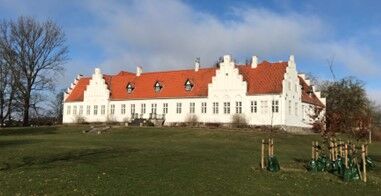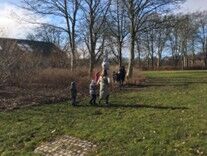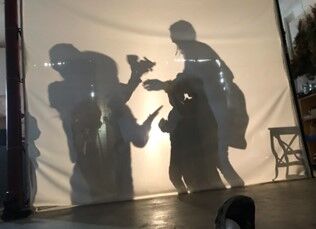PLAY, ART, CULTURE, AESTHETIC PROCESSES, CO-CREATION, COLLABORATION, COMMUNITY, VISUAL ARTS, PAINTING, STORYTELLING
REGION: Sjælland
MUNICIPALITY: Næstved
PROCEDURE: 2022
DAILY OFFER: All of them kindergartens and SFO's (preschool groups)
Snood Storytelling: Stories in Motion (2022)
How have you experienced the co-creation between artist/cultural educator/cultural school teacher, educators and children and possibly researcher?
In the spring of 2022, the LegeKunst program Tales in motion has been rolled out in all kindergartens and SFO's (preschool groups) in Næstved municipality. 900 preschoolers have thus visited Kunsthallen Rønnebæksholm and an artist/cultural educator from Billedskolen when they were in kindergarten and again after they started in SFO (the change takes place as of 1/4 in Næstved municipality).
The overall SNIP narrative was: "How can we say YES to each other's ideas", and was about how children and their educators together with artists at Rønnebæksholm could meet in a creative 'open space' and together create stories that could help bridge the children's transition from kindergarten to SFO. In 2022, Tales in Motion has had a performative, narrative and visual arts focus.
The co-creation took place from the start of the year, when educators from all kindergartens and after-school centers met with the artists (a total of five artists) for joint online start-up seminars (in January) before the courses started. The artists have had the lead on what was to happen during the visits to Rønnebæksholm - namely work with a storytelling suitcase, shadow play and folding figures/rod puppets - while educators and children have been able to continue working at home in the institutions (for example, they received a small suitcase with shadow play figures (in the kindergarten) and rod puppets (in the SFO)).
On each visit to Rønnebæksholm, educators and children brought a gift for the artists. It could be a game or a song, for example, and the days started by 'unwrapping this gift' - i.e. doing the activity guided by educators and children. The artists then started the planned activities - always in dialog and interaction with both educators and children, which meant that there was room for variation in the individual courses.
How have children's perspectives been expressed/included?
Using a fixed framework (based on a suitcase full of artifacts), Tales in Motion invited children to create a story with the artist.
The children have thus been involved in choosing figures/characters/props for a story that arose in the moment from the contents of the suitcase. The children have also made (drawn and painted) folding figures that were subsequently put on sticks and thereby 'transformed' into rod puppets that could be used in shadow play and, for example, retell the story.
Do the children play different games and with different people than they usually do?
One of the project's objectives was to create a common connection between children from different kindergartens so that the children had a common reference when they met for the first time in the SFO. It was also hoped that the children would have had experiences and played games that they could use in the new SFO context and in the new community.
The general impression is that the common reference has not played a major role in the children's first meetings in the SFO, where they have to relate to a new reality and everyday life. However, when the SFO children visit Rønnebæksholm, there is a clear recognition and a lot of impressions and experiences that reappear in the children's consciousness. The children themselves are not very articulate about what exactly they did at Rønnebæksholm (or 'the white castle', as one child called it) when they were there in kindergarten. But they have a clear (shared) experience that they have been here, played and made stories before.
How do pedagogical staff act differently than they did before PlayArt?
Many of the participating educators express that they have gained inspiration and ideas for working with narrative, among other things. Other educators have also mentioned that it can be challenging to navigate in a co-creative and 'open' space, which often leads to a kind of chaos and loss of overview. In some institutions, the snip-snap-snip concepts have led to new ways of organizing and evaluating creative processes.
To the artist/cultural educator/cultural school teacher, if present: What have you gained from participating in LegeKunst?
The artists have had an educational process that has offered many intimate moments and important co-creative experiences with the children. They have also been challenged by many institutional visits to each artist and several 'corona obstacles'.
What are educators still/now curious about?
There is still a curiosity about how the LegeKunst course and the work with the playful, artistic element and aesthetic processes can be made even more relevant in relation to the bridge-building work and help create a unique common narrative for the 900 future schoolchildren who will participate in the project in 2023.
How will you use art, culture and aesthetic processes in the future?
Fortunately, the project will be repeated in 2023, and the lessons learned - both successes and challenges - from 2022 will be carried over to next year.
In the new program, there will be a stronger focus on the transition between kindergarten and SFO, and portals will be used. In 2023, the artistic activities will be directed towards visual arts, so it will be possible to immerse oneself more at the same time, and there will be greater recognition from the first to the second visit.
click on the picture to see a larger version





